If anyone was curious, my blood type is A+, blood pressure currently squirting through my veins at 110/60, weight is 77kg (169 lbs.), and I contain no known quarantinable diseases. Yes, I'm quite healthy, and now I have verified proof of that fact. This is due to the poking and prodding I recently endured at the hands of Chinese doctors in order to get my 'foreign experts' license (diploma?). X-rays, urine samples, blood tests, sonigrams, and EKG were all procured. I feel like this exam probably gave me 0.1% additional chance of cancer later in life, just due to invasiveness of the measurements. A sonigram? Did they expect to find me pregnant, a la a stupid Arnold Schwarzenegger movie? Or perhaps, an alien lifeform incubating somewhere between my stomach and my pancreas, ready to pop out and infest the countryside?
In any case, no alien lifeforms, and no other excuse to deport me. Excellent.
Friday, October 26, 2007
Thursday, October 25, 2007
Fashion Trends
(NB:Bear with my descriptions, I'm no fashionisto either.)
Styles of dress in China easily identify various socio-economic classes. The poorest people in China live in the countryside. Other than Tibetans, and the women of a few other minorities, China's peasants don't usually wear traditional dress. Today, plastic flip-flops, army surplus jackets, and bland t-shirts are the norm. Hair worn up in a pink towel may sometimes be substituted for a traditional headdress. The next rung up the ladder (barely up the ladder, and on a precarious and dangerously overstrained rung at that) are migrant labor that have recently come to the city. Their attire is about the same as their cousins in the countryside, because they probably shop at the same second-hand clothing markets.
Soon after arriving in the big city, however, the lower class tends (oddly) to dress in a full business suit, usually black or charcoal grey. True, the suit jacket is almost always too large, the slacks stained. The shiny black shoes of the would-be social-climber must be the main source of income for all those street shoe polishers. Seeing immediately identifiable over-dressed plebs, I can only liken them to the (perhaps cleaner, but not better dressed) Communist Party dinosaurs that often found hawking a loogie at all the finer resorts and tourist traps of China. I suppose that mimicry is the truest form of flattery, as they say.
The middle class, by contrast, can be more accurately described as a fashion zoo: all the strangest clothing ideas that Chinese fashion designers can shove out the door are displayed each day on the average urban teenager or blue-collar folk. Polka dots and candy stripes, crimes against the English language printed proudly across the front and back of T-shirts and on the seats of pants, absurb copyright infringements (Mickey and Spiderman conspire to switch identities), clothy tentacles that apparently serve no practical purpose, kitsche and glitter taken to new vainglorious dimensions. You get the idea. China's domestic clothing industry relies on this daring (or tasteless) demographic.
The upper class (that is the young pampered spawn of dinosaurs as well as the new industrialists) are by far the best dressers. I'm no great judge of such matters, in fact, but Asian friends in college always used to joke that the easiest way to tell a Chinese from a Korean or a Japanese was the tasteless manner of dress. I would suggest to them now, that they might have difficulty telling the difference with this new, cosmopolitan uppercrust gradually moving radpidly away from its nouveau riche baby years, much less the more distant, mao-suited past.
Styles of dress in China easily identify various socio-economic classes. The poorest people in China live in the countryside. Other than Tibetans, and the women of a few other minorities, China's peasants don't usually wear traditional dress. Today, plastic flip-flops, army surplus jackets, and bland t-shirts are the norm. Hair worn up in a pink towel may sometimes be substituted for a traditional headdress. The next rung up the ladder (barely up the ladder, and on a precarious and dangerously overstrained rung at that) are migrant labor that have recently come to the city. Their attire is about the same as their cousins in the countryside, because they probably shop at the same second-hand clothing markets.
Soon after arriving in the big city, however, the lower class tends (oddly) to dress in a full business suit, usually black or charcoal grey. True, the suit jacket is almost always too large, the slacks stained. The shiny black shoes of the would-be social-climber must be the main source of income for all those street shoe polishers. Seeing immediately identifiable over-dressed plebs, I can only liken them to the (perhaps cleaner, but not better dressed) Communist Party dinosaurs that often found hawking a loogie at all the finer resorts and tourist traps of China. I suppose that mimicry is the truest form of flattery, as they say.
The middle class, by contrast, can be more accurately described as a fashion zoo: all the strangest clothing ideas that Chinese fashion designers can shove out the door are displayed each day on the average urban teenager or blue-collar folk. Polka dots and candy stripes, crimes against the English language printed proudly across the front and back of T-shirts and on the seats of pants, absurb copyright infringements (Mickey and Spiderman conspire to switch identities), clothy tentacles that apparently serve no practical purpose, kitsche and glitter taken to new vainglorious dimensions. You get the idea. China's domestic clothing industry relies on this daring (or tasteless) demographic.
The upper class (that is the young pampered spawn of dinosaurs as well as the new industrialists) are by far the best dressers. I'm no great judge of such matters, in fact, but Asian friends in college always used to joke that the easiest way to tell a Chinese from a Korean or a Japanese was the tasteless manner of dress. I would suggest to them now, that they might have difficulty telling the difference with this new, cosmopolitan uppercrust gradually moving radpidly away from its nouveau riche baby years, much less the more distant, mao-suited past.
Monday, October 22, 2007
Controversy
The idea of controversy itself may be controversial in a country such as China. The powers that be certainly don't like it, are threatened by it, do everything they can to dampen such an explosive human tendency. Perhaps that's why the Chinese, outsiders to US politics, often have a difficult time understanding the divisive nature of our national postures and policies, the myriad of opinions which swarm out of every dialogue concerning every conceivable issue.
Take gun control, a subject that often comes up in my more advanced English classes. Listening in on the class, you might often hear such opinions as: "Americans love guns", or "Americans are more violent than other [nationalities]". Iraq is another example. I always have to explain that for most controversial issues (including gun control), there tends to be a near 50/50 split in public opinion as well as the representative government. But how to really explain that to people used to keeping mum on political issues and funneling their most vituperative energies towards bargaining?
"But why would the government allow people to keep guns?" My students ask. I explain the frontier (and separationist) mentality behind the constitutional ammendments, as well as the difficulty in changing them. An ultimate crackdown on guns could theoretically lead to a crackdown on free speech, or a blow to the wall between church and state. The 'happy' middle ground between freedoms and protections can be very difficult to maintain.
It is true, however, that I actually do feel safer here in China than I did in the US. I've only witnessed one riot in the year+ that I've resided in China. Guns do make acts of violence perhaps easier to contemplate, cleaner to execute. As the refrain goes, 'guns don't kill...' but they certainly facilitate the act. But violence is a fundamental human drive, and even in a country with near-absolute gun control (organized criminals or Hei Se Hui do manage to obtain weapons from corrupt PLA connections), dispossessed peasants, minorities, and migrant workers have increasingly often managed acts of attrocity without the use of the metal cylinder--in an incident last June, an intruder walking into a primary school and throwing six children off of a balcony, killing a nine-year-old girl.
I have the suspicion that as China continues to open up, its markets irrevocably interconnect with the outside world, and the perspectives contained within it--if not its government--democratize, this country will soon be no stranger to controversy. The sharp divides in lifestyle between affluent urbanites and their rural kin are no joke, as migrant workers are encouraged by the government to flood into the cities (precursor to a massive corporate agricultural land grab?) where they eat the evening restaurant refuse, shoulder burdens for pocket change, and beg or steal. The government has done a good job of exporting electricity and satellite tv into even the most destitute and remote corners of the Chinese empire (for purposes of propaganda and the general stupifying effect that TV can have), but an unintended consequence may be that more and more people become aware of just how many material fantasies they are missing out on in the post-communist era.
I do find it annoying when Chinese like to poke fun about the diverse controversies and volatilities the American life contains, but I suspect that they are soon to learn about these problems more personally. Perhaps that future contains some lessons that Americans and Chinese alike could learn from.
Take gun control, a subject that often comes up in my more advanced English classes. Listening in on the class, you might often hear such opinions as: "Americans love guns", or "Americans are more violent than other [nationalities]". Iraq is another example. I always have to explain that for most controversial issues (including gun control), there tends to be a near 50/50 split in public opinion as well as the representative government. But how to really explain that to people used to keeping mum on political issues and funneling their most vituperative energies towards bargaining?
"But why would the government allow people to keep guns?" My students ask. I explain the frontier (and separationist) mentality behind the constitutional ammendments, as well as the difficulty in changing them. An ultimate crackdown on guns could theoretically lead to a crackdown on free speech, or a blow to the wall between church and state. The 'happy' middle ground between freedoms and protections can be very difficult to maintain.
It is true, however, that I actually do feel safer here in China than I did in the US. I've only witnessed one riot in the year+ that I've resided in China. Guns do make acts of violence perhaps easier to contemplate, cleaner to execute. As the refrain goes, 'guns don't kill...' but they certainly facilitate the act. But violence is a fundamental human drive, and even in a country with near-absolute gun control (organized criminals or Hei Se Hui do manage to obtain weapons from corrupt PLA connections), dispossessed peasants, minorities, and migrant workers have increasingly often managed acts of attrocity without the use of the metal cylinder--in an incident last June, an intruder walking into a primary school and throwing six children off of a balcony, killing a nine-year-old girl.
I have the suspicion that as China continues to open up, its markets irrevocably interconnect with the outside world, and the perspectives contained within it--if not its government--democratize, this country will soon be no stranger to controversy. The sharp divides in lifestyle between affluent urbanites and their rural kin are no joke, as migrant workers are encouraged by the government to flood into the cities (precursor to a massive corporate agricultural land grab?) where they eat the evening restaurant refuse, shoulder burdens for pocket change, and beg or steal. The government has done a good job of exporting electricity and satellite tv into even the most destitute and remote corners of the Chinese empire (for purposes of propaganda and the general stupifying effect that TV can have), but an unintended consequence may be that more and more people become aware of just how many material fantasies they are missing out on in the post-communist era.
I do find it annoying when Chinese like to poke fun about the diverse controversies and volatilities the American life contains, but I suspect that they are soon to learn about these problems more personally. Perhaps that future contains some lessons that Americans and Chinese alike could learn from.
Saturday, October 20, 2007
Spies and Spectres
Kids scream like banshees in my lower-level classes, and my thoughts turn to one of my favorite holidays, Halloween (which is only surpassed in my morbid heart by the celebration of Guy Fawkes's execution). I have to plan a Halloween promotional event for the end of the month, and the size limitations of this school somewhat frustrate me. We do have some 230 students. Trick-or-treat may be doable. Haunted Teacher's Lounge may also be doable--with me under a black sheet and bloody mouth as the resident spectre there. Apple-bobbing? No, too un-hygienic. Ghost stories? Let's save that for class. Sugary sweets should be the show-pony of this particular event. They always were when I was growing up, taste for the macabre or not.
Yesterday I dropped by one of our competitors, a local English training school chain. I was spending a pleasant autumn afternoon in suburban Chongqing and thought, 'why amuse myself by being a spy?' They may have been a little suspicious. But oh, the humanity!--I was so jealous. This school I spied upon had great facilities: TVs in every classroom, designer desks that perform an S-curve on their way from floor to ceiling, suited curriculum consultants. An uncomfortable interview in which I tried to get as much information as I could about the teaching contracts offered (extremely, boringly standard) while my girlfriend attempted to pry other details out of the desk staff. I suppose our act could be improved (they seemed a bit suspicious), but this was a fun exercise. Perhaps I have a future in acting? The BBC, with its penchant for odd-looking character actors with bulbous noses and crotchety croakings ought to appreciate me, I would think.
Yesterday I dropped by one of our competitors, a local English training school chain. I was spending a pleasant autumn afternoon in suburban Chongqing and thought, 'why amuse myself by being a spy?' They may have been a little suspicious. But oh, the humanity!--I was so jealous. This school I spied upon had great facilities: TVs in every classroom, designer desks that perform an S-curve on their way from floor to ceiling, suited curriculum consultants. An uncomfortable interview in which I tried to get as much information as I could about the teaching contracts offered (extremely, boringly standard) while my girlfriend attempted to pry other details out of the desk staff. I suppose our act could be improved (they seemed a bit suspicious), but this was a fun exercise. Perhaps I have a future in acting? The BBC, with its penchant for odd-looking character actors with bulbous noses and crotchety croakings ought to appreciate me, I would think.
Friday, October 12, 2007
Adventures in Kham Tibet (part 2)
or, "The Yaks Among Us" (September 30 - October 3rd)
 From Kangding, the bus ride over the high pass (elevation: 4200 m) into the alpine prairies around Tagong was no less jolting than I remembered. Certainly the new paved road made things worse and only taunted us as I routinely slammed my hat into the ceiling. Herds of shaggy yaks and black mountain-pigs graze the slopes between islands of shrubbery--spinach green, coagulated-blood red, watery gold--and occasionally raise near-sighted eyes to greet the arrival of this dilapidated beast we ride in. The Tibetan architecture has changed radically in the last 1000 meters of elevation, fortress-boxes now composed almost entirely of rocks mortared with mud, precious timber used mainly for interior supports and decoration. The top level is often open at the sides and only ceilinged three-quarters, more of a barn for drying barley or straw (yaks' winter diet?).
From Kangding, the bus ride over the high pass (elevation: 4200 m) into the alpine prairies around Tagong was no less jolting than I remembered. Certainly the new paved road made things worse and only taunted us as I routinely slammed my hat into the ceiling. Herds of shaggy yaks and black mountain-pigs graze the slopes between islands of shrubbery--spinach green, coagulated-blood red, watery gold--and occasionally raise near-sighted eyes to greet the arrival of this dilapidated beast we ride in. The Tibetan architecture has changed radically in the last 1000 meters of elevation, fortress-boxes now composed almost entirely of rocks mortared with mud, precious timber used mainly for interior supports and decoration. The top level is often open at the sides and only ceilinged three-quarters, more of a barn for drying barley or straw (yaks' winter diet?).
 Tagong is slightly more touristy, more "found" by small tourist crowds than it was last year. Granted, I come during a 'Golden Week', that apex of the Chinese tourism calendar. There are at least three or four more hostels/hotels in town than before, and one Chongqing-style lowlander restaurant. Oh, for shame, but we do eat there with other waiguoren we had met on the bus (one Israeli, one Chinese-Australian, one Canadian).
Tagong is slightly more touristy, more "found" by small tourist crowds than it was last year. Granted, I come during a 'Golden Week', that apex of the Chinese tourism calendar. There are at least three or four more hostels/hotels in town than before, and one Chongqing-style lowlander restaurant. Oh, for shame, but we do eat there with other waiguoren we had met on the bus (one Israeli, one Chinese-Australian, one Canadian).
The Tibetan family whose home I stayed at last time remember me, and are eager to welcome us back into the fold. Mmm, home-cooked meals! Ayi (auntie, a polite honorific) also gives us a discount, especially important given that during Golden Week, prices for everything usually double in China.
Sketching yaks on the prairies outside town--the yaks grudgingly ignore our efforts at immortalizing their hairy brows--turns into a conversation with some young Tibetan boys who share sunflower seeds with us. Among the piles of yak shit, wildflowers mirror the sky with such incredible shades of blue.
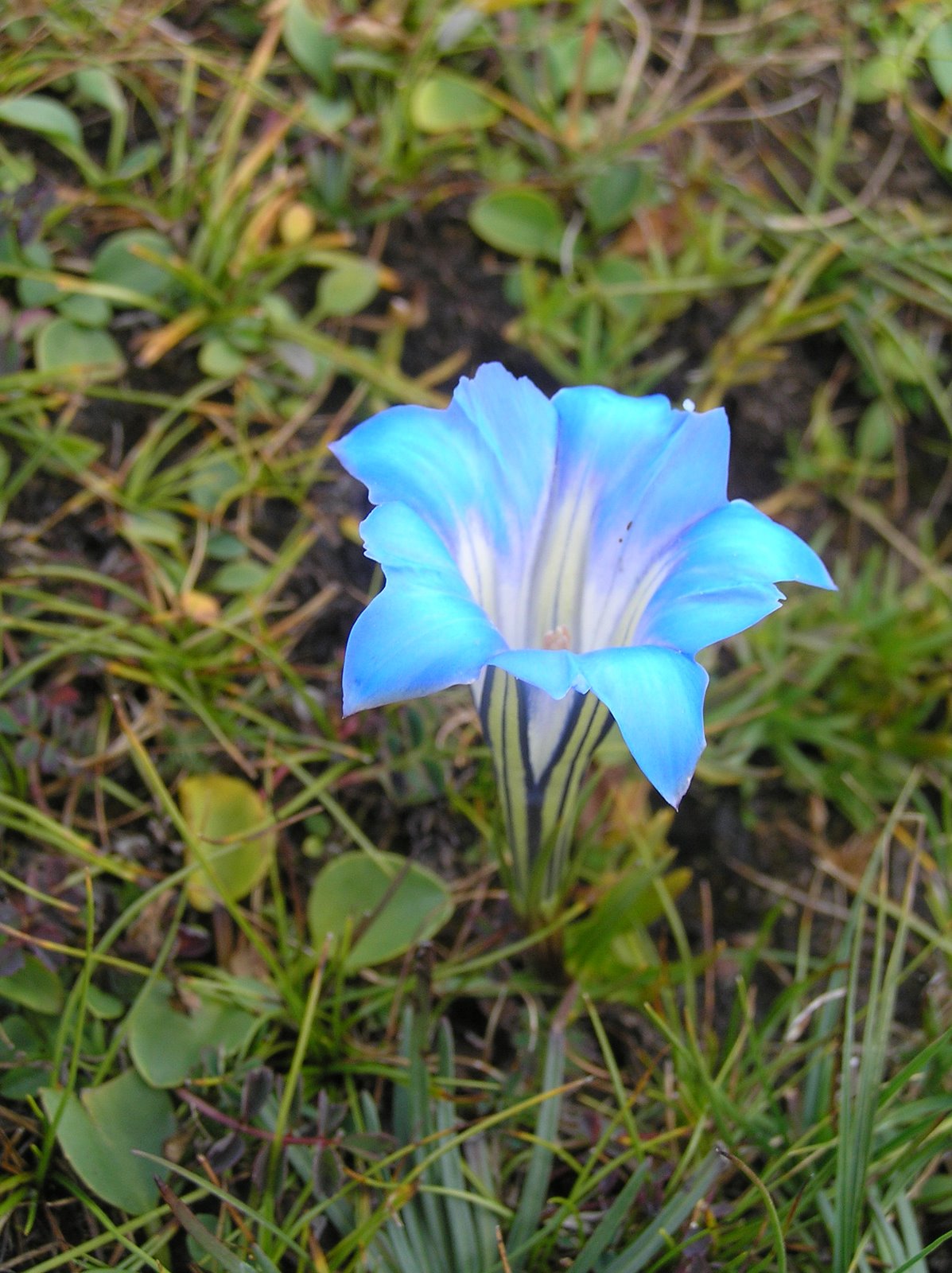
 The skies over Chongqing are never clear, and between the foggy weather and light pollution, few stars can be seen in its night sky. Like I remember my father once doing for me, in the deserts of Death Valley, we walk into the black of nigh outside of town to marvel at the clarity with which thousands of cold stars might glare down upon us.
The skies over Chongqing are never clear, and between the foggy weather and light pollution, few stars can be seen in its night sky. Like I remember my father once doing for me, in the deserts of Death Valley, we walk into the black of nigh outside of town to marvel at the clarity with which thousands of cold stars might glare down upon us.
The next day we catch up with some nomadic yak-herders, out in the hills beyond town. Here you can see them attempting to untie a rope from a rather uncooperative yak. More obedient yaks were already geared up and decked out with sacks of this and that. Also, a young yak calf appeared to be hog-tied to his mother's back.
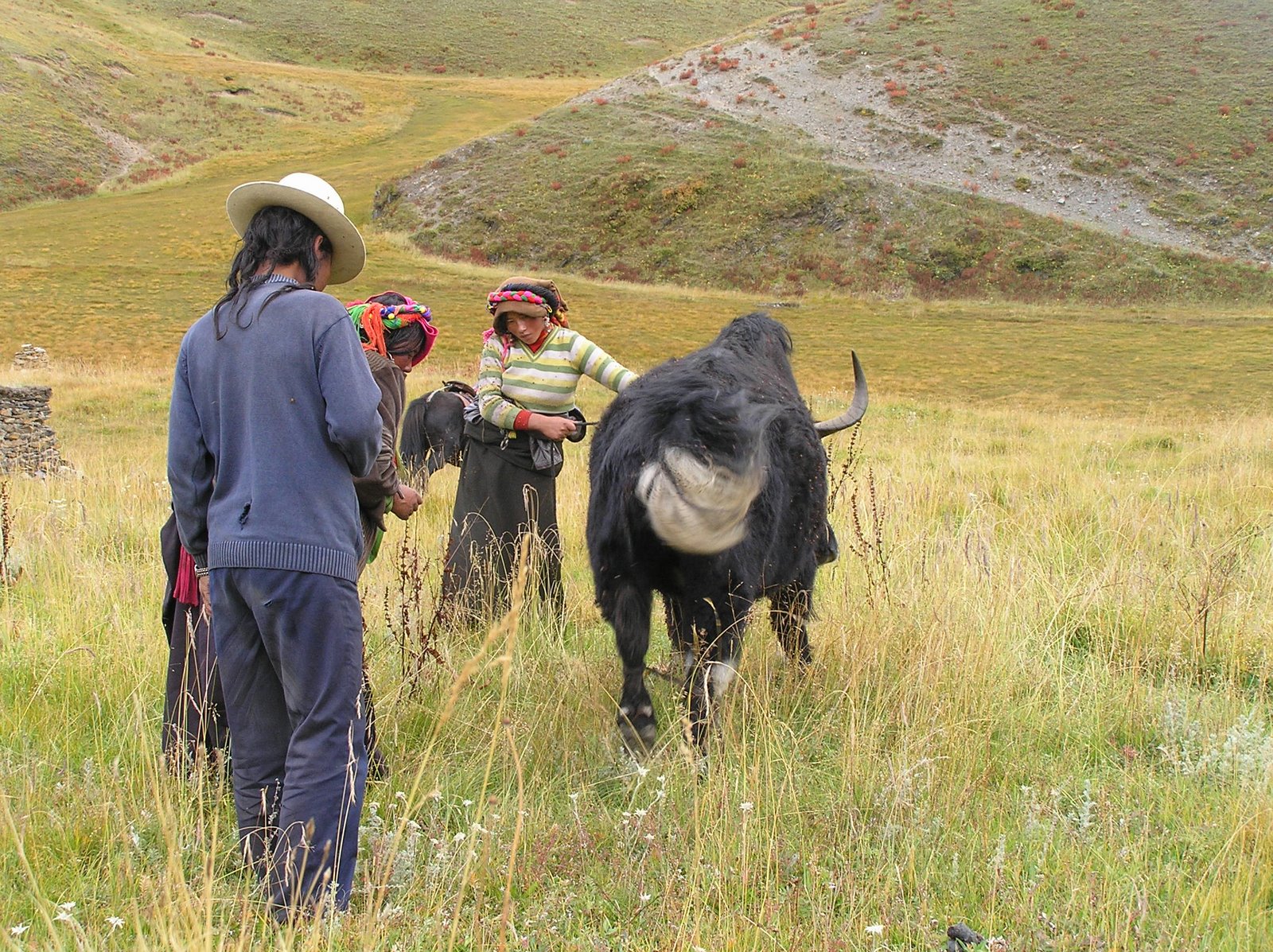
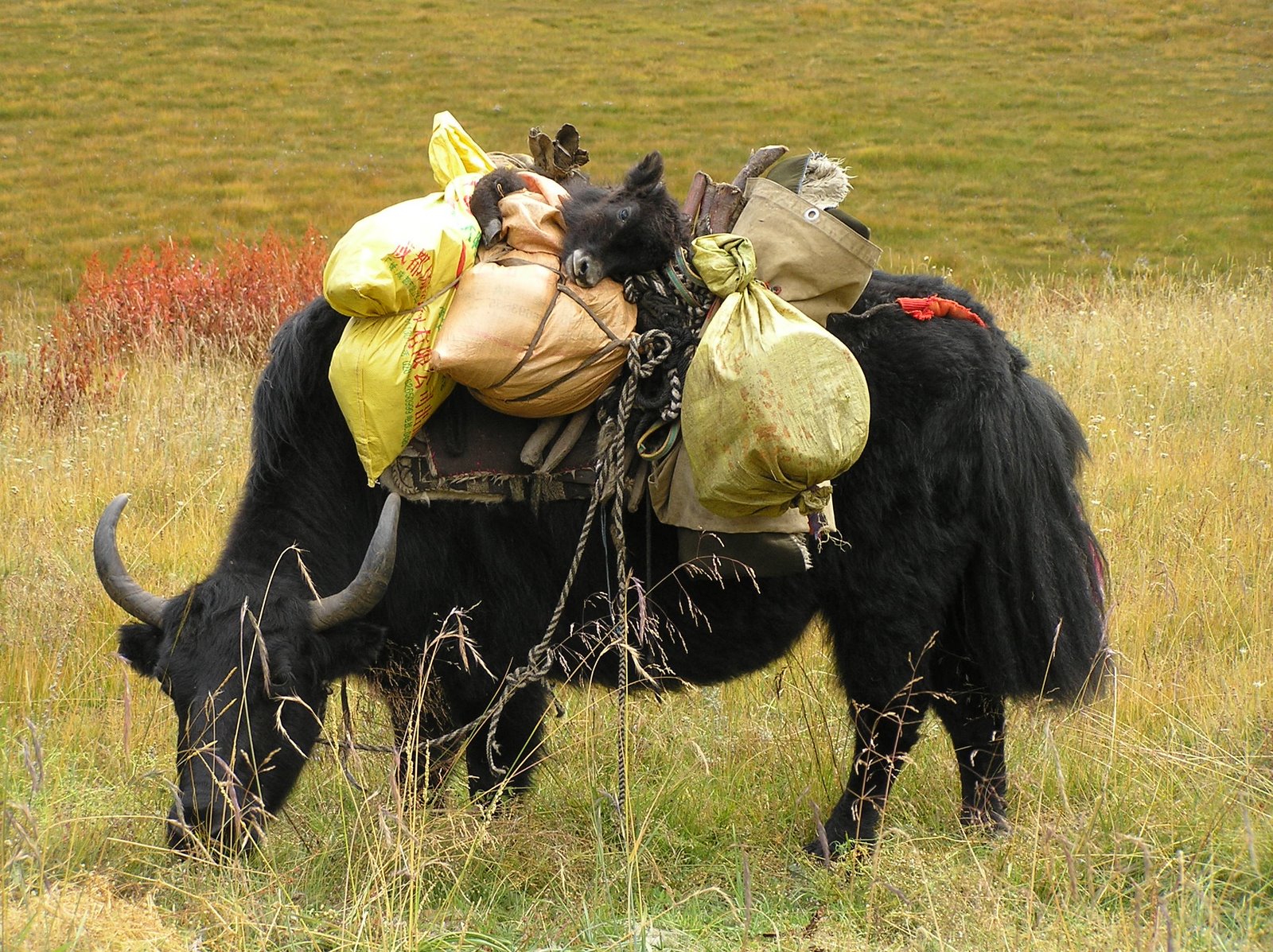
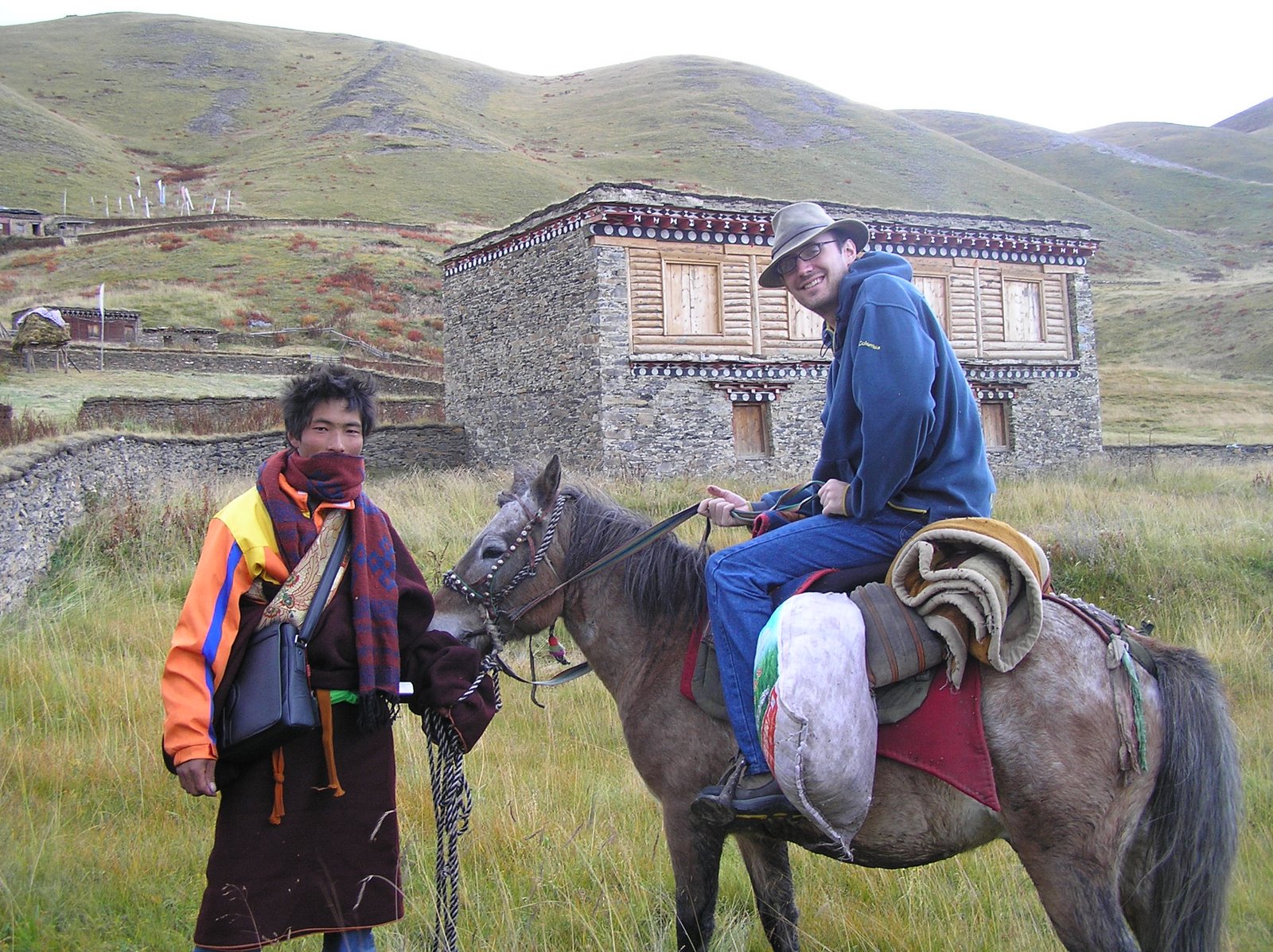 In the couple days it takes us to wend our way back down the windy mountains to civilization, my mind is still occupying that peaceful place. I knew of a peaceful place in an otherwise chaotic and stressful country, and I'm glad to have found that place again. Getting to play tour guide was a bonus. I just wonder how long those hills can remain peaceful. But these days, the lonely stupas still rise between the grassland and the lowering skies, like the prayers they represent. Tibetan scripture is carved into the hills, into pieces of slate, written across prayer-flags whipping back and forth in the ever-present wind and on the temples' prayer-wheels (moved only by the hands of the penitent).
In the couple days it takes us to wend our way back down the windy mountains to civilization, my mind is still occupying that peaceful place. I knew of a peaceful place in an otherwise chaotic and stressful country, and I'm glad to have found that place again. Getting to play tour guide was a bonus. I just wonder how long those hills can remain peaceful. But these days, the lonely stupas still rise between the grassland and the lowering skies, like the prayers they represent. Tibetan scripture is carved into the hills, into pieces of slate, written across prayer-flags whipping back and forth in the ever-present wind and on the temples' prayer-wheels (moved only by the hands of the penitent).
 Chengdu (above) during Golden week, compared to Tagong (below).
Chengdu (above) during Golden week, compared to Tagong (below).
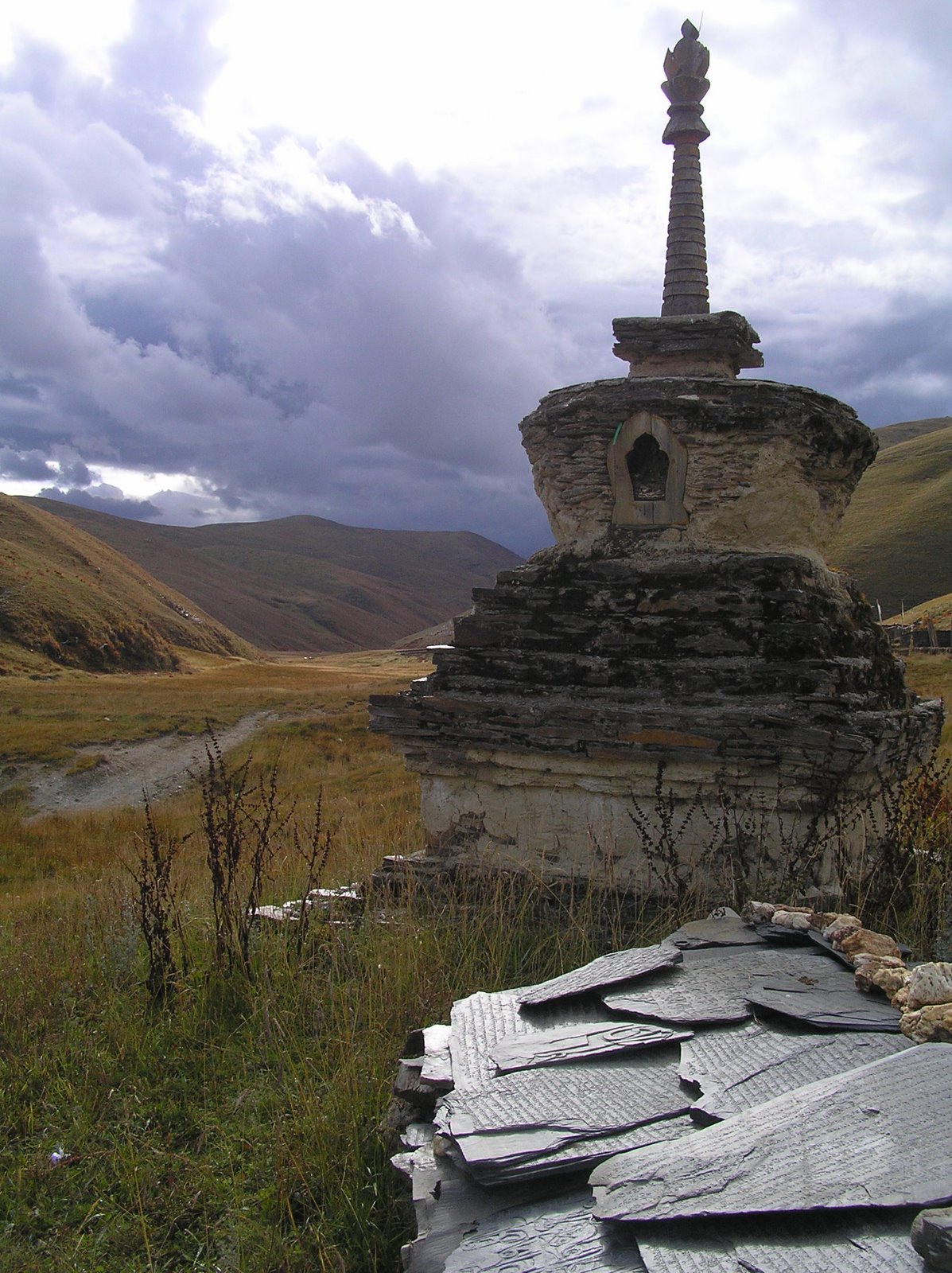
The Tibetan family whose home I stayed at last time remember me, and are eager to welcome us back into the fold. Mmm, home-cooked meals! Ayi (auntie, a polite honorific) also gives us a discount, especially important given that during Golden Week, prices for everything usually double in China.
Sketching yaks on the prairies outside town--the yaks grudgingly ignore our efforts at immortalizing their hairy brows--turns into a conversation with some young Tibetan boys who share sunflower seeds with us. Among the piles of yak shit, wildflowers mirror the sky with such incredible shades of blue.
The next day we catch up with some nomadic yak-herders, out in the hills beyond town. Here you can see them attempting to untie a rope from a rather uncooperative yak. More obedient yaks were already geared up and decked out with sacks of this and that. Also, a young yak calf appeared to be hog-tied to his mother's back.
Thursday, October 11, 2007
Adventures in Kham Tibet (part 1)
(September 27th - September 29th)
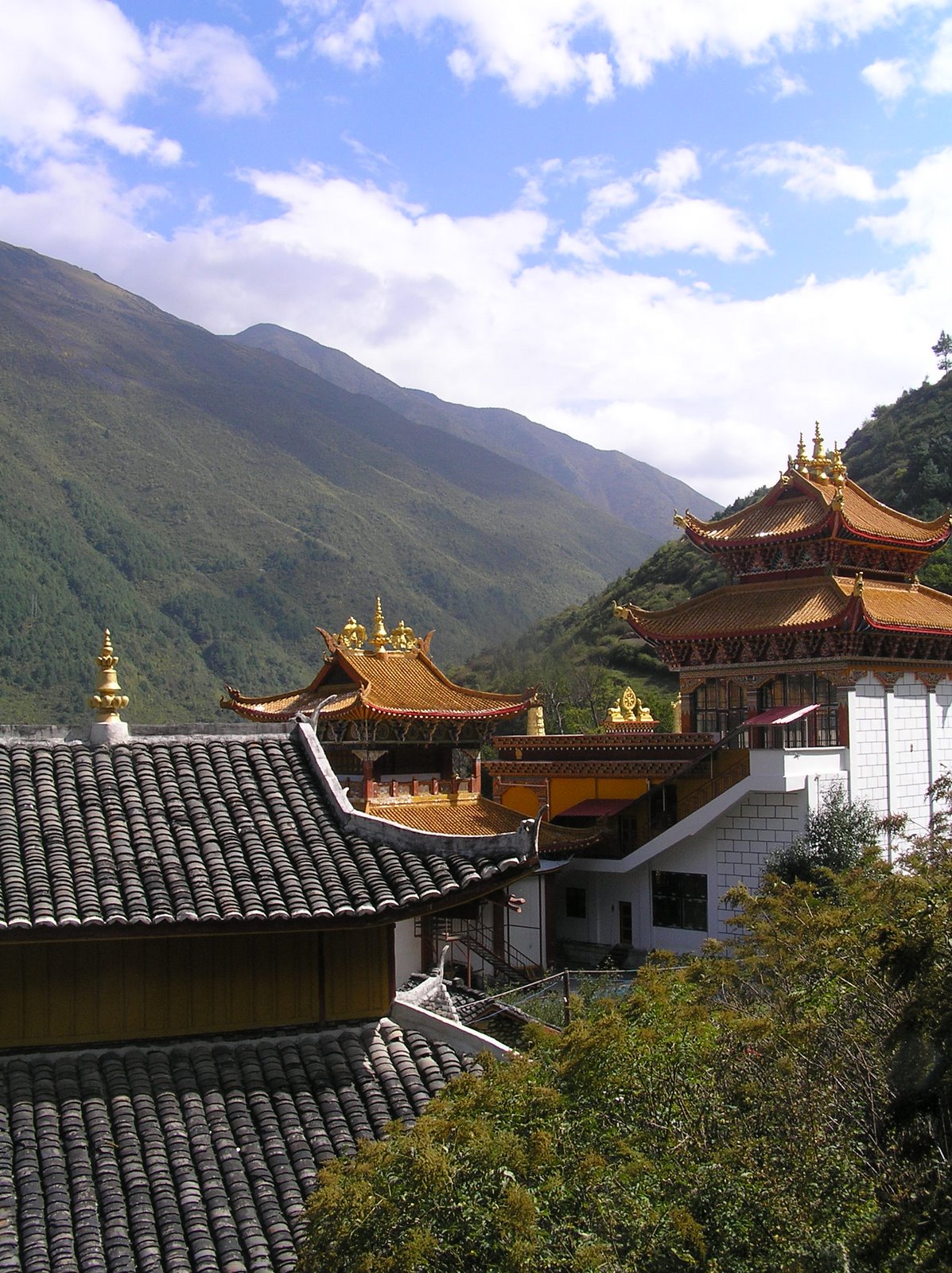
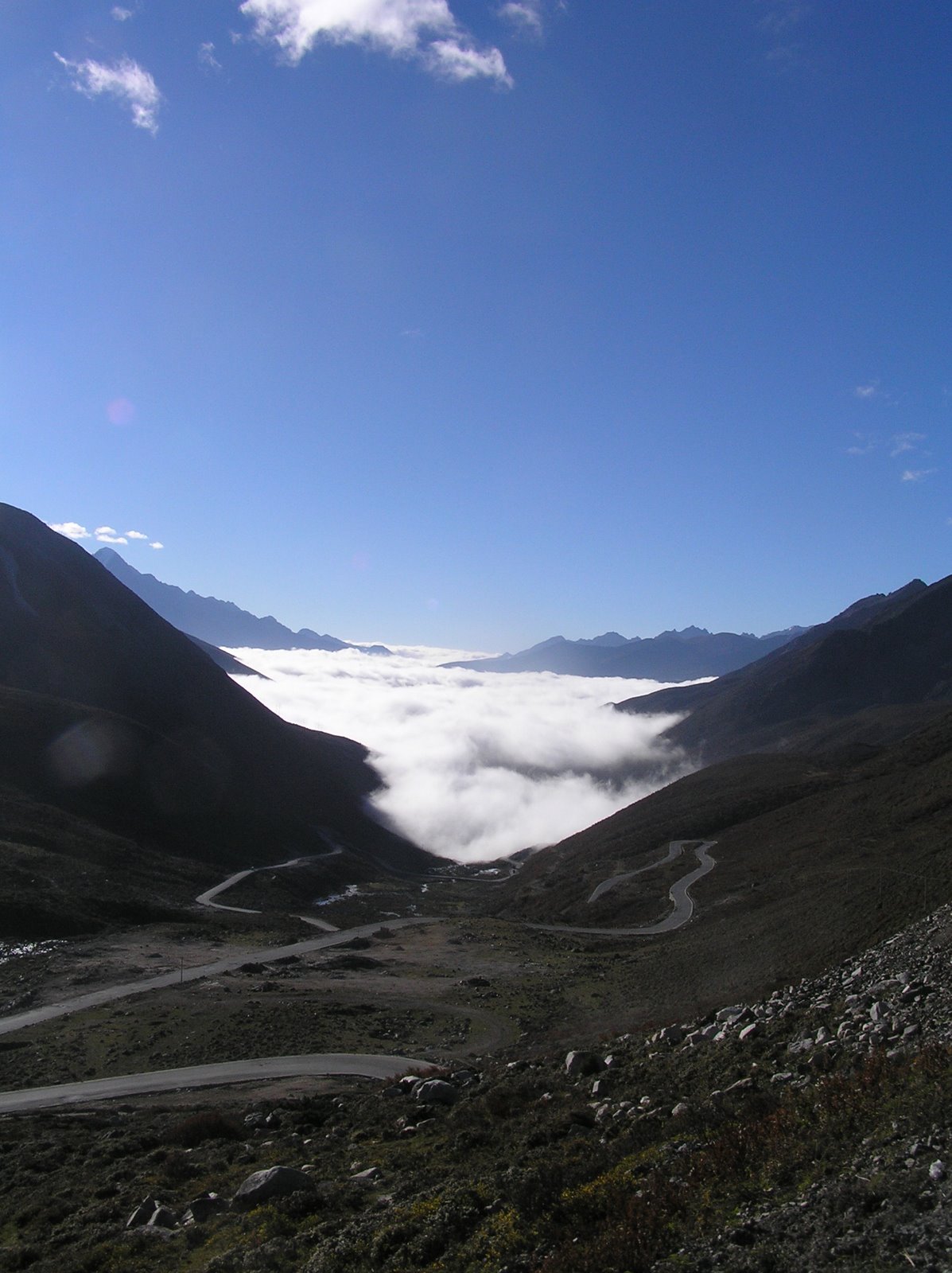 I have to say, Tibetan food rather sucks. Being a people who live at high altitude, at the very edge of sustainable habitability, they just don't have a lot of food options to work with. There's yak meat (cold cut, boiled in stew, or stuffed in dumplings), yak butter (used in tea, mostly), yak cheese (not really what I had been praying for), barley flour (folded into yak butter tea to make a doughy staple of the Tibetan diet, called 'tsampa), and yak yoghurt (extremely sour, use with sugar and extreme caution). These days other vegetables and fruits can be had (at expense) shipped up from the lowlands, and are not really a traditional part of the Tibetan diet. Some of the Kangding local cuisine (a fusion of Tibetan and lowlander Chinese styles) was quite interesting, however. My amor and I dined upon--I kid you not--walnut twigs and blossoms soaked in oil and spice, as well as a local version of 'twice-cooked pork' which was twice as tasty as the lowlander version.
I have to say, Tibetan food rather sucks. Being a people who live at high altitude, at the very edge of sustainable habitability, they just don't have a lot of food options to work with. There's yak meat (cold cut, boiled in stew, or stuffed in dumplings), yak butter (used in tea, mostly), yak cheese (not really what I had been praying for), barley flour (folded into yak butter tea to make a doughy staple of the Tibetan diet, called 'tsampa), and yak yoghurt (extremely sour, use with sugar and extreme caution). These days other vegetables and fruits can be had (at expense) shipped up from the lowlands, and are not really a traditional part of the Tibetan diet. Some of the Kangding local cuisine (a fusion of Tibetan and lowlander Chinese styles) was quite interesting, however. My amor and I dined upon--I kid you not--walnut twigs and blossoms soaked in oil and spice, as well as a local version of 'twice-cooked pork' which was twice as tasty as the lowlander version.
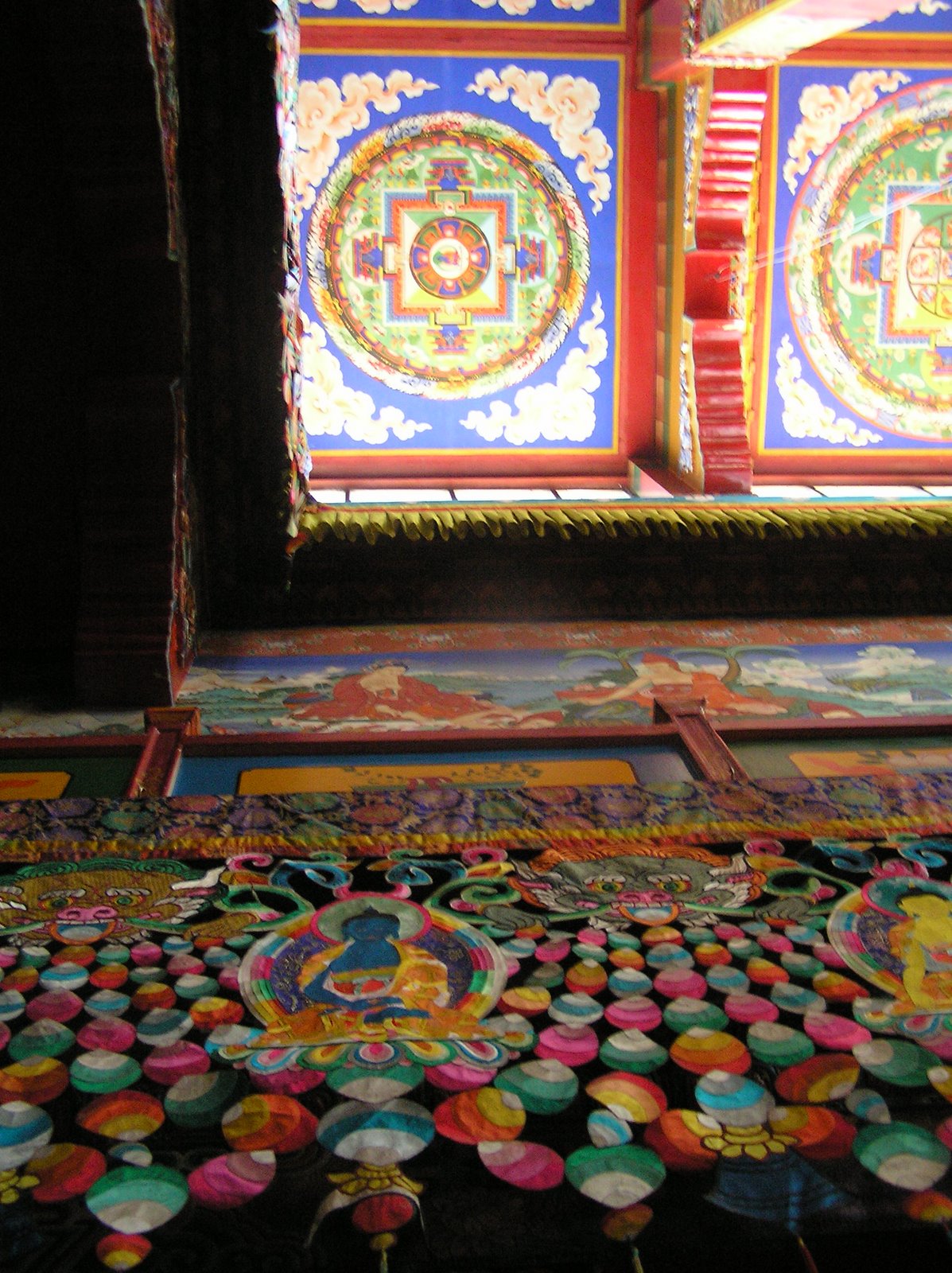
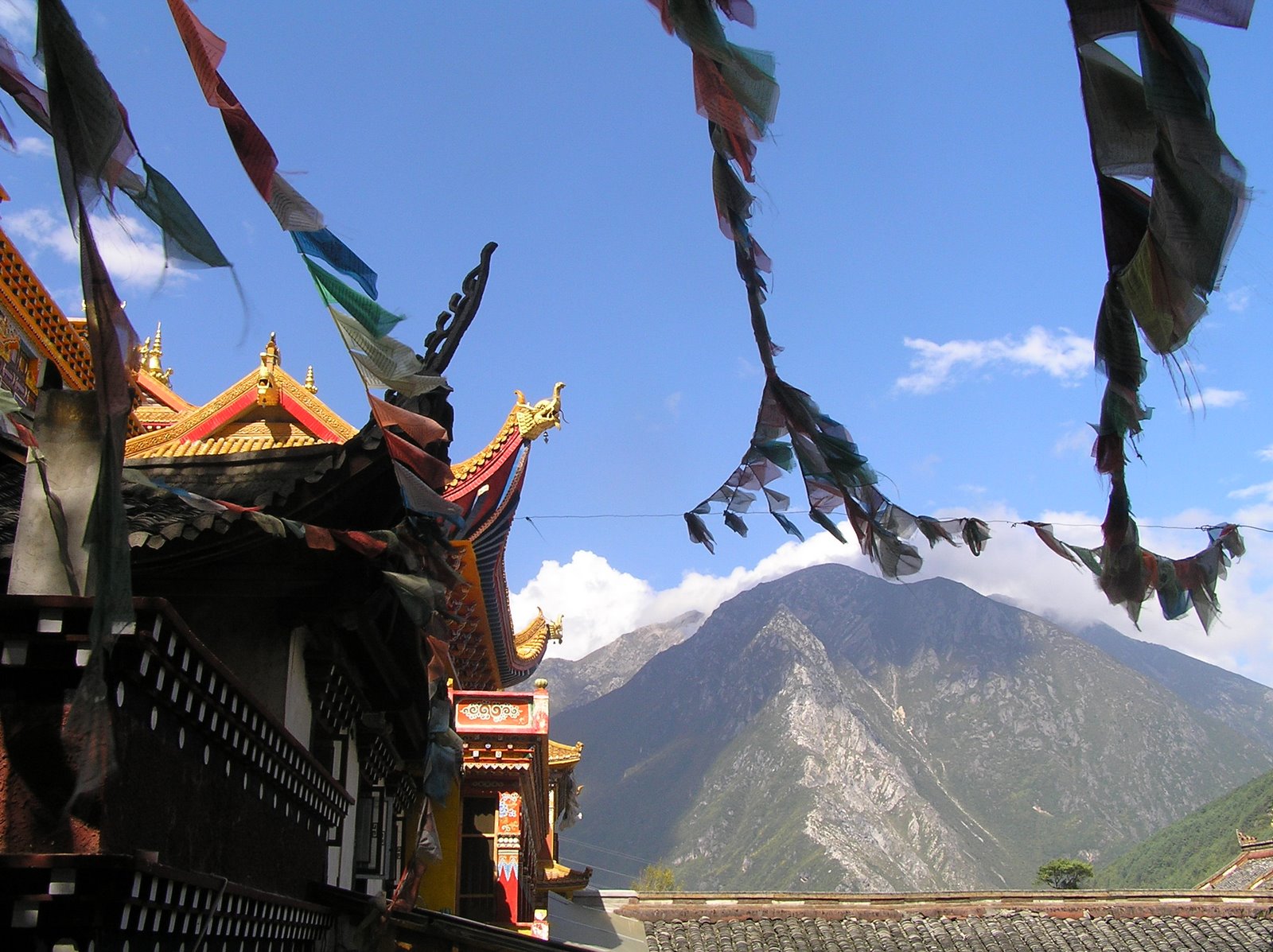
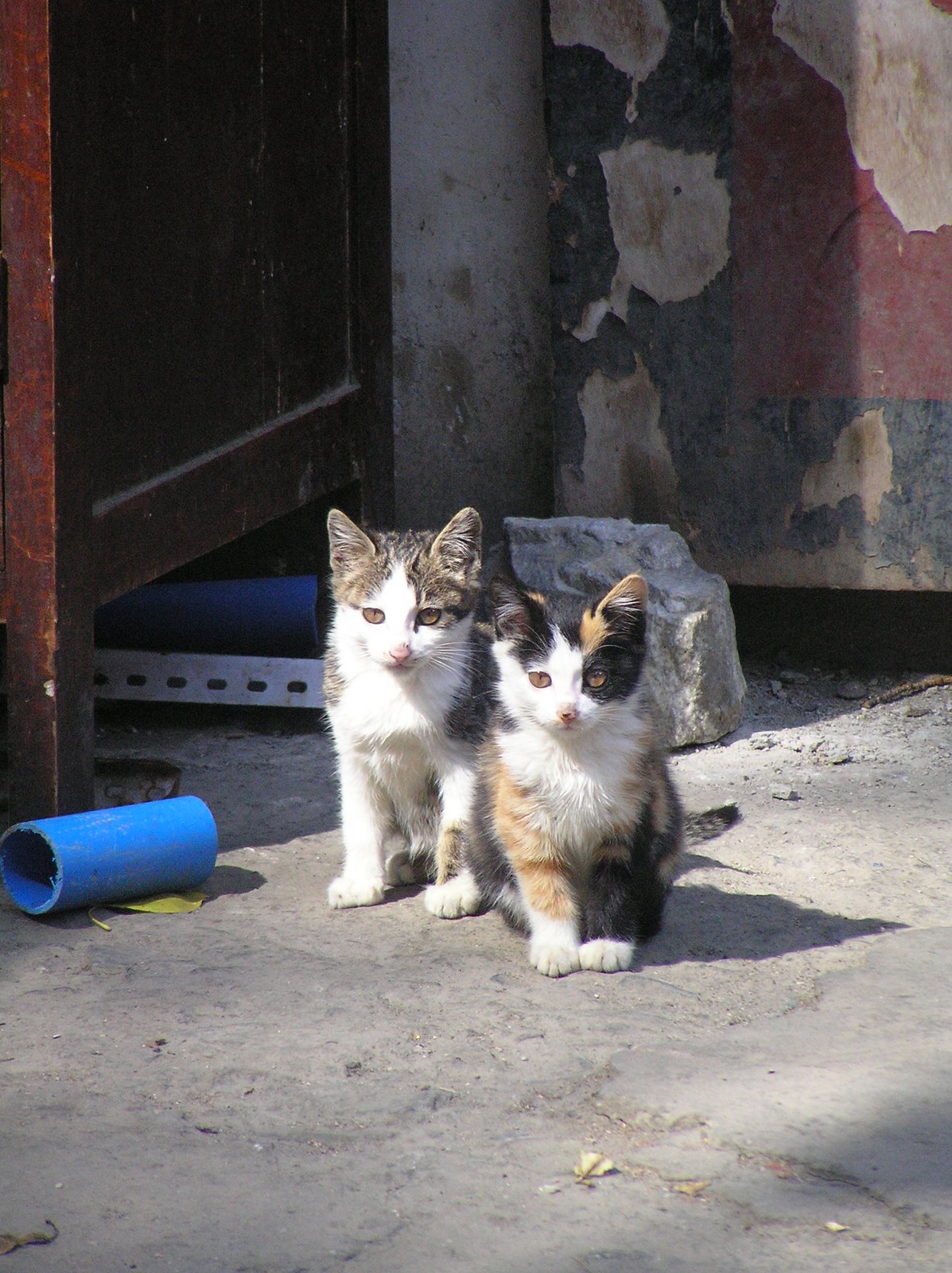 Okay, I couldnt' resist throwing the kittens in. The monks of that particular monastery (an ancient monastery dating back at least to Qing Dynasty times, according to the painting of the Qianlong Emperor bringing gold and leopard pelts up the mountain to their 'holy monkishnesses') were kind enough to keep a whole herd of cats and dogs about the premises.
Okay, I couldnt' resist throwing the kittens in. The monks of that particular monastery (an ancient monastery dating back at least to Qing Dynasty times, according to the painting of the Qianlong Emperor bringing gold and leopard pelts up the mountain to their 'holy monkishnesses') were kind enough to keep a whole herd of cats and dogs about the premises.
China's National Day holiday is one of but three opportunities for the laboring masses of this overpopulated country to take a week (or two) off--to cavort about the main tourist attractions of China (or just its raucous train stations, garish tourist-traps, and smoky mahjong dens). So at least 120 million Chinese took advantage of the opportunity, this year. My girlfriend and I were among them.
(No, I'm not going to disclose more details on that little tidbit. Strange for an avid blogger like myself to say, but I value some last vestige of my privacy. Let us move along.)
From Chongqing's foggy, tortuous hills to the flatlands of Chengdu by train, and then up from the Sichuan Basin into the misty, bamboo-encrusted foothills of the Himalayas we traveled. Having made the same journey last year, I can honestly say that the 8 hour bus ride from Chengdu to Kangding is much easier with company (reading being impossible on those twisting roads).
The proclaimed 'home of Panda'--we didn't see any--is a wild, beautiful, and not terribly hospitable territory for human habitation. The Khambas (an isotope of Tibetan) dig small plots from nearly vertical land in order to grow their crops of corn and barley. At this altitude yak herding is not yet prevalent. Wooden houses (somewhat in the style of barns) attest to the deep forests which used to successfully claw their way of up the cliffs.
Below Kangding the river gorge has been tamed with several very new, very modern-looking hydropower stations/dams. In places, water has been diverted for kilometers through subterranean canals carved through the mountainside, only to spew foaming from the cliff--and generate some electricity?--later on down the canyon.
Kangding is known throughout China as the source of the 'Kangding Love Song'. Supposedly the song depicts the love of a shepherd (goatherd? yakherd?) for a wild, mountain girl who is very good at keeping house and baking whatever the Tibetan equivalent of pies might be (yak stew?). I really enjoy this song, in fact, and performed it for all the parents and students at our Aston School graduation ceremony this last August, to wild applause.
"Pao ma liu liu di shan shang; yi duo liu liu di yun yo! Duan duan liu liu di zhao zai; Kangding liu liu di cheng yo! Yue liaaang, wa-aaan, wa-aaaaaaaaaaan. Kangding liu liu di cheng yo!"
We spent a day in Kangding, avoiding temple guard dogs at the local Buddhist temple and finding a nice place for sketching, up on an isolated patch of untilled farmland behind the temple.
In any case, I'll finish presenting my holiday account in the second part. "The Yaks Among Us", wherein we continue on to the Tagong alpine prairies.
Tuesday, October 9, 2007
My Blog is Dead, Long Live My Blog!
Well, it seems that I'm back from the void. The abyss which had gobbled up numerous--now hypothetical and quantum probable--blog postings over the past few months consisted of the best efforts of a very busy work schedule, the censorship apparatus of the Chinese government, and the website redesign efforts of Live Journal.
I am sorry, both for the loss of my own writing pleasure, and the general lack of communication lately. I do hope you'll bookmark this new blog, and we can now recommence that telepathic relationship of writer and reader.
The latest news from your correspondent in that 'Chicago of China', Chongqing, is that he has signed a further one-year contract with Chongqing Aston English School, to be Foreign Manager til the end of August 2008. While I had never planned to remain in China through the Olympic fiasco, I suppose it is a chaotic and interesting time to live here, and there should be much to report on. I'm also acquiring a lot of valuable experience as "The Man" or "The Boss", a role I had never imagined myself in, and am loathe to give it up just yet, just as I begin to figure things out.
The next posting should encompass my last and most recent week of travels (Sept. 27th--Oct. 3rd). In that week, I returned to Kangding and Tagong in the region known as Kham Tibet, some sixteen bus and train hours from Chongqing.
Viva la blog!
I am sorry, both for the loss of my own writing pleasure, and the general lack of communication lately. I do hope you'll bookmark this new blog, and we can now recommence that telepathic relationship of writer and reader.
The latest news from your correspondent in that 'Chicago of China', Chongqing, is that he has signed a further one-year contract with Chongqing Aston English School, to be Foreign Manager til the end of August 2008. While I had never planned to remain in China through the Olympic fiasco, I suppose it is a chaotic and interesting time to live here, and there should be much to report on. I'm also acquiring a lot of valuable experience as "The Man" or "The Boss", a role I had never imagined myself in, and am loathe to give it up just yet, just as I begin to figure things out.
The next posting should encompass my last and most recent week of travels (Sept. 27th--Oct. 3rd). In that week, I returned to Kangding and Tagong in the region known as Kham Tibet, some sixteen bus and train hours from Chongqing.
Viva la blog!
Subscribe to:
Posts (Atom)
